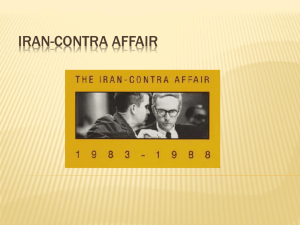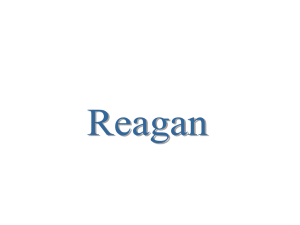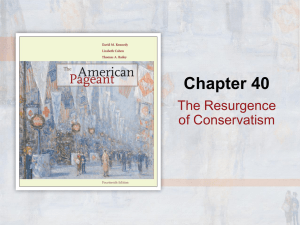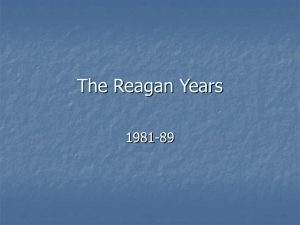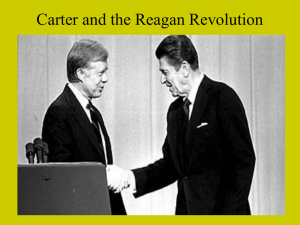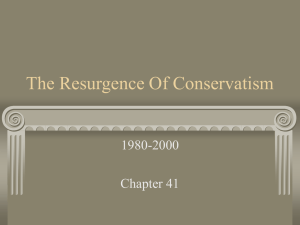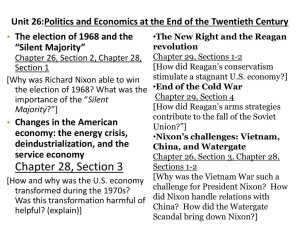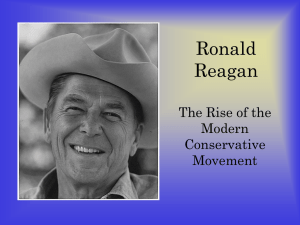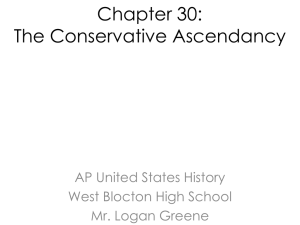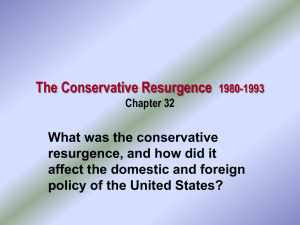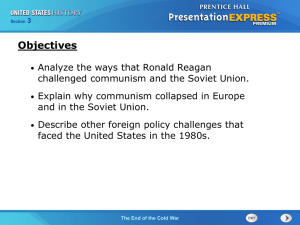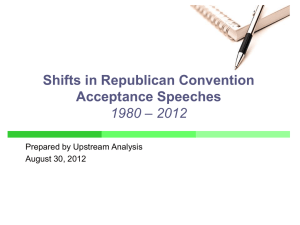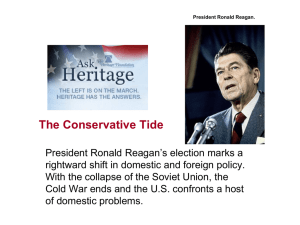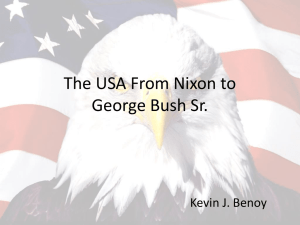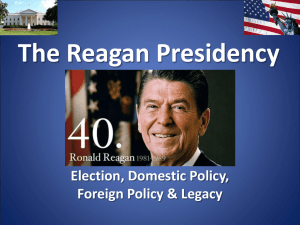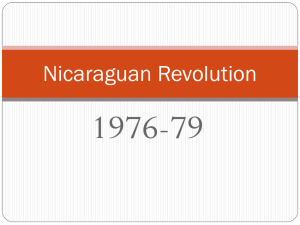power point 40 - Long Branch Public Schools
advertisement
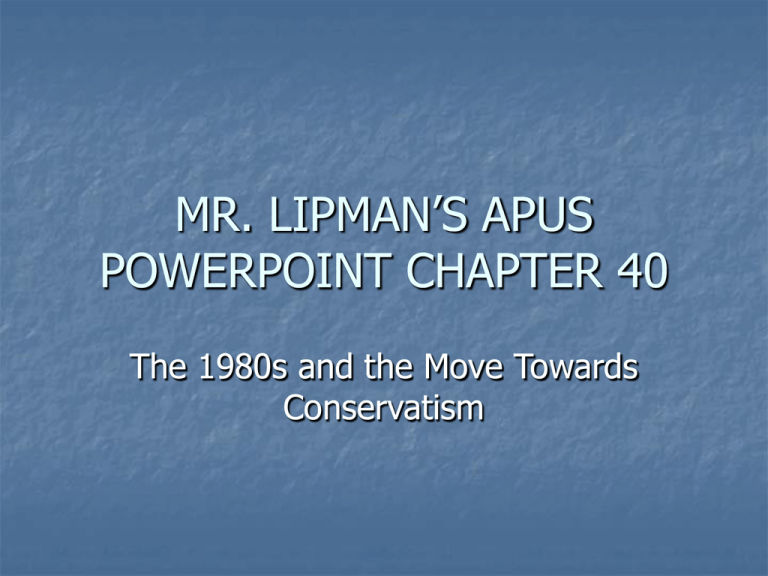
MR. LIPMAN’S APUS
POWERPOINT CHAPTER 40
The 1980s and the Move Towards
Conservatism
KEYS TO THE CHAPTER
Supply Side Economics
Military Build-up (restart cold war / stars wars)
Reaganomics (contain gov’t welfare state)
Iran Contra Scandal
Mikhail Gorbachev (glasnost / perestrokia/ Yelstin)
Moral Majority
China (Tiananmen Square)
Bush 1 (Operation Desert Storm)
Reagan Denounced activist government
Championed “common man”
Worked to win over lower-middle-class whites
Democrats by appealing to their sense of loss
Argued for free-market capitalism, less
government regulation, and hard-line antiSoviet position on foreign policy
Reassertion of traditional family values
Ronald
Reagan
Carter:
Gracious
in defeat;
Working
for
Habitat
for
Humanity
and
Nobel
Prize
Changes in govt spending (1960 –80)
Federal budget went from primarily national
defense to entitlement programs
Reagan is devoted to fiscal discipline and
leaner federal government: end entitlement
growth and spending
“Government is not the solution to our problem.
Government is the problem.”
The Aftermath of Reagan’s Assassination
3/30/1981
Reagan’s tax cuts (supply side economics)
25% across-the-board reductions in 3 years
Reagan wins because of his skill on TV and the
continued defection of the “boll weevils”
(Southern Democrats)
1981 – Congress passed tax reforms
Lowered individual tax rates
Keeping budget under control and tax reduction would
stimulate new investment
Theory of
SupplySide
Economics
The
Laffer
Curve
1981 – 1982 – deepest recession since 1930s
but later in the 1980s economy will pick up
Unemployment reached 11% by 1982
Businesses folded; bank failures occurred
Automobile industry pummeled by Japanese
Democrats argue Reagan’s tax and spending
cuts hurt poor and favored the rich
Reason for the economic upturn late 1980s
was not tax cuts but large military spending
Put US deeply into debt
Massive government borrowing led to high
interest rates
US transformed from world’s largest
creditor to world’s largest debtor nation
Results of Increasing income inequality
during the 1980s
Reversal of long-term trend toward more
equitable distribution of income
Increasing squeeze on poor and middle class
Large deficits make future expansion of social
welfare programs almost impossible (forced to
shrink gov’t programs)
The National Debt 1930 - 1999
Trickle-Down Theory in Reality
Reagan Renews the Cold War
Reagan’s hard-line stance toward USSR
Expansion of military spending
Force USSR to spend lots of money to counter USA
Reagan believed in negotiating with USSR from
position of overwhelming strength
SDI {Strategic Defense Initiative aka “Star Wars”}
Problems in Central America
1979 – Sandinistas overthrew dictator of Nicaragua
Reagan accused Sandinistas of allowing Soviet base to
attack US & claimed Nicaragua shipping arms to
revolutionaries in El Salvador
Secret aid (including the CIA mining harbors) to
Nicaragua’s “contra” rebels (fighting the Sandinistas)
October 1983 – US forces sent to Grenada, where
communist coup had taken over country
A Group of U.S. supported Contra Special Forces on
Patrol In a Remote Area of Northern Nicaragua, 1983
Bringing Democracy to Nicaragua
The 1984 election
Reagan easily won the Republican nomination
Riding high on prosperity and strong foreign policy
Walter Mondale won Democratic nomination
Congresswoman Geraldine Ferraro (NY) –
first woman to run for vice president on
national ticket
Results
Reagan won big
March 1985 – USSR installed new chairman of
Communist party, Mikhail Gorbachev
Announced 2 policies-lead to revolutionary changes
“Glasnost”
– “openness”, introduction of
free speech and political liberties in USSR
“Perestroika”
– “restructuring” of
economy by adopting some practices of
capitalist West - like profit motive
Mikhail
Gorbachev
-----------4 Summits with
Reagan
----------Changes USSR
away from
Communist
doctrine
2 major foreign policy problems – and
Reagan finds a way to link them together
Continuing capture of US hostages by Muslim
extremist groups in Lebanon
Continuing power of Sandinistas in Nicaragua
Reagan requested aid for contras, but US Congress
refused
Linkage between hostages and Sandinistas
1985 – US secretly arranged arms sales to Iran
In return, Iran would help get US hostages held by terrorists
Money from payment of the arms was diverted to the contras
Violation of law banning on military aid to contras
Violation of Reagan’s repeated promise that he would
never negotiate with terrorists
November 1986 – news of the secret Iran-contra deal
broke (Reagan initially denies knowledge)
Reagan Admits on
T.V. That Staff
Traded Arms for
Hostages with Iran
and Funneled
Profits to the
Contras, March
1987
Religion and politics combined in favor of
Republicans in 1980s
1979 – Reverend Jerry Falwell from Virginia founded
the Moral Majority
Against sexual permissiveness, abortion, feminism, gay rights
“televangelists” used radio, direct-mail marketing,
cable TV to reach huge audiences and raise millions
Swaggert; Robertson; Jim and Tammy Baker
Protest at the Capitol in Favor of School Prayer
Organized by the Moral Majority, 1984
Courts were Reagan’s chief weapon in
“culture wars”
Appointed almost 1/2 of all sitting judges
Named 3 Supreme Court justices including
Sandra Day O’Conner
Court reduces impact of affirmative action
1992 – Planned Parenthood v. Casey
States
could restrict access to abortion as
long as it did not place an “undue burden”
on the woman
But Bork nomination will fail in 1987
George H.
Bush
----------Defeats
Dukakis in
1988 on
Reagan’s
record
Communism falls and democracy begins in
former communist block nations
China
Spring 1989 – pro-democracy demonstrators
marched into Tiananmen Square in Beijing
June 1989
Tanks rolled over demonstrators, machine-gunners
killed hundreds
US and world condemned the attack
Bush insisted on keeping normal relations
A Sea of Student Protesters Gathers in Tiananmen Square on May 4,
1989, Demanding Greater Freedom of Speech and Democracy
Tank Man Blocks the Path of a Convoy Near Tiananmen Square
Former communist-controlled Eastern Europe
falls in just a few months in 1989
August – Solidarity movement in Poland
overthrew the communist government
Communist governments then fell in
Hungary, Czechoslovakia, East Germany,
and Romania
December 1989 – Berlin Wall torn down
October 1990 – 2 Germanys reunited
Changes in the USSR:
August 1991 – hard-line communists
attempted coup of Gorbachev but failed
USSR dissolved into separate republics
Russia itself, led by Boris Yeltsin
Governments ended communism and
began democratic and free-market
reforms
December 1991 – Gorbachev resigned
Destruction
in Panama
after the US
Invasion,
1989, to
arrest
President
Manuel
Noriega
The Persian Gulf Crisis
August 2, 1990 – Iraq invaded Kuwait
Needed Kuwait’s oil to pay its war bills (after
fighting an 8-year war with Iran)
Larger plan was control over entire Middle
East, to control world’s oil supply
US supplied Hussein with weapons and
money during 1980s
US knew he was a brutal dictator but he also
opposed Iran so we helped him
Feb.1991 – “Operation Desert Storm”
Land war in Iraq led by coalition forces through UN
Lasted 4 days – the “hundred hour war”
February 27, 1991 – Hussein accepted cease-fire
and Kuwait was liberated
Saddam Hussein remained in power
Allies had agreed only to remove Iraq from Kuwait, not
regime change
Gen. Norman
Schwarzkopf
Commander
of Operation
Desert Storm
1991
Bush and the “social issues”
Had promised “Kindler and Gentler Nation”
but:
1990 – Bush’s Department of Education challenged
scholarships targeted to minorities
promised to veto law that would make it easier to
prove discrimination in hiring
nominated Clarence Thomas to Supreme Court &
hearing will lead to Anita Hill revelations.
Problems for Bush lead to Clinton victory
“gender gap”
Economy
Women more critical of Republicans and joined Democrats
Weak performance and relatively high (7%) unemployment
Tax increase
1990 – Bush agreed to $133 billion in new taxes
Violated his 1988 campaign pledge: “Read my
lips—no new taxes.”
